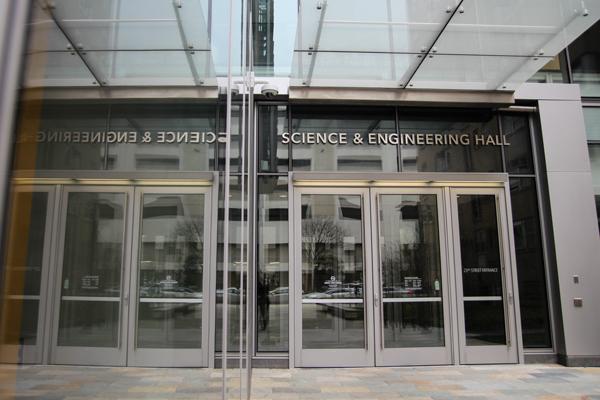Updated: Oct. 21, 2016 at 4:27 p.m.
The number of women earning bachelor’s degrees in engineering and computer science at GW is steadily increasing.
GW was listed as one of the universities with the most women working toward degrees in engineering and computer science in an analysis by The Washington Post. The University was ranked 12th in the nation based on the the percentage of women earning bachelor’s degrees in engineering and landed at No. 9 for the percentage of women earning bachelor’s degrees in computer science in 2015.
Nationally, an average of 20 percent of women earn bachelor’s degrees in engineering and 16 percent earn bachelor’s degrees in computer science, according to the Post. But the University’s average for women in these majors is double the national numbers at 42 percent for engineering degrees and 38 percent for computer science degrees.
David Dolling, the dean of the School of Engineering and Applied Science, said in an email that although SEAS has been successful in attracting female students and faculty, officials still hope to increase those numbers.
The Post report focused on undergraduate students, but Dolling noted that female enrollment is also high at the graduate level: Female enrollment for master’s degrees is 20 percent higher than the national average, and doctoral program female enrollment sits just above the national average.
Dolling added that SEAS has been actively recruiting female faculty, recently hiring three women: Mona Diab, Lorena Barba and, most recently, Emilia Entcheva last spring.
“Overall, about 20 percent of the tenured or tenure track faculty in SEAS are women, about 50 percent above the national average for engineering schools,” he said. “We hope to grow this percentage dramatically over the next several years.”
Poorvi Vora, a professor of computer science, said in an email that officials have appealed to female students by making SEAS more supportive through mentoring programs for freshmen and by promoting an inclusive community.
“Our undergrad recruiting effort includes presentations by faculty during student visits. Many of our faculty present lectures with interactive exercises that include current students who participate and talk about their experiences at GW,” Vora said. “We seek to make this set of students and faculty, like the group of mentors, diverse.”
Increasing diversity and making diverse student populations within SEAS visible is important for recruiting and retaining students who may have otherwise felt like they did not fit in, Vora said.
She added that faculty can help attract and retain female students.
“Having women professors is important because then female students can imagine themselves working in the field,” she said. “It becomes possible. Also, the presence of a women in higher levels gives women a feeling of belonging to the organization, and the glass ceiling appears higher.”
Experts said that the percentage of women graduating with bachelor’s degrees in engineering and computer science demonstrate that GW has been successful in recruiting women – something most engineering schools are pushing for but have struggled with.
Nasir Memon, a professor of computer science and engineering at New York University’s Tandon School of Engineering, said that female enrollment in these programs is only one part of a larger issue: Engineering schools’ professors and administrators must encourage women to stay in engineering programs until they graduate.
“We make sure we have women faculty that are talking to the prospects because one of the most important aspects of recruiting them is making sure the right role models are around,” Memon said. “But enrollment is one thing. What is much more challenging is providing that culture, that nurturing culture, that supports women throughout the program so that they stay in the program.”
Engineering is a growing field that needs just as many women as men to join, Memon added.
Christine M. Hartzell, an aerospace engineering professor at the University of Maryland’s A. James Clark School of Engineering, said studies show that more diverse engineering teams that include women produce more creative results. But unfortunately, there is still gender bias in engineering, she said.
“Beyond the commercial aspect, there is the moral imperative: that women should be able to choose whatever field of study they want, without being discouraged by society,” Hartzell said. “There is absolutely still bias against women joining these fields. I see this whenever I fly on an airplane: 90 percent of the time, the person sitting next to me is shocked to find out that I’m an engineer.”
Sera Royal contributed reporting.
This post was updated to reflect the following correction:
The Hatchet incorrectly spelled Poorvi Vora’s first name. It is now spelled correctly. We regret this error.







